Trails & Tales of Wharton – May 2025
Introducing "Trails & Tales of Wharton", a new monthly publication of nature and history related articles written by Wharton State Forest's nature and history interpretive staff!
A Nature Note: "You Lookin' At Me?"
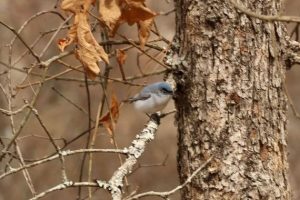 Fiercely territorial, if the blue-gray gnatcatcher could talk he might say something close to a Robert De Niro line. These small, constantly fluttering blue/gray
Fiercely territorial, if the blue-gray gnatcatcher could talk he might say something close to a Robert De Niro line. These small, constantly fluttering blue/gray
birds are common in Wharton State Forest in the spring, summer and fall. Breeding males are easy to identify by their eyebrows! No they’re not true eyebrows... but
a black “V” that goes over both of their eyes. You might see them in the low/outer branches of our trees and shrubs, flicking their tails back and forth to stir up bugs to
eat. They seem to be calling constantly and moving quickly from branch to branch so snatching this photo was not easy!
Gil Mika
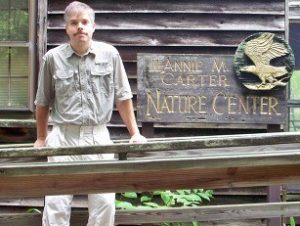 If you’ve visited the Annie Carter Nature Center, you’ve probably had the pleasure of talking to Gilbert (Gil) Mika. It’s with great sadness that we share that Gil
If you’ve visited the Annie Carter Nature Center, you’ve probably had the pleasure of talking to Gilbert (Gil) Mika. It’s with great sadness that we share that Gil
passed away last month. Gil served as the naturalist at the Annie Carter Nature Center in Batsto Village from the mid-1990s until his retirement in 2020. Through
his passion for the outdoors and dedication to interpretation, Gil inspired countless school children and hundreds of thousands of visitors to develop a greater
appreciation for Batsto and the New Jersey Pinelands. His impact continues to be felt today—through the wayside exhibits he created, the trails he developed
and maintained, and the brochures that are still in production.
Registration is open for the Sand and Water Trail Nature Hike!
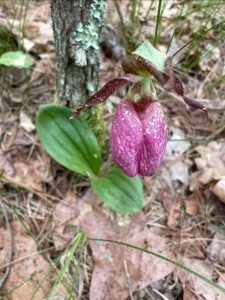 Join Wharton State Forest’s Naturalist for a hike on the Sand and Water Trail. Participants will walk about 1.7 miles, at a moderate pace, through sandy uplands and
Join Wharton State Forest’s Naturalist for a hike on the Sand and Water Trail. Participants will walk about 1.7 miles, at a moderate pace, through sandy uplands and
some mixed Atlantic White cedar swamp habitat, stopping periodically to talk about different habitats in the Pine Barrens and some of the species that live there. Very little
elevation change and sandy soil makes this an easy hike, but participants should be prepared to walk across multiple, uneven wood bridges, step over shallow roots and
some fallen trees. The hike will begin behind the Batsto Visitor Center at 10 AM. Please wear appropriate clothes and shoes and bring plenty of water. This hike is not
ADA accessible and will be canceled if there are thunderstorms or heavy rain in the area. This hike is free and open to the public, but it is recommended for adults and
children over the age of 12. Registration is required. Registration will close once we reach
capacity.
For more information, please call the Batsto Visitor Center at 609-561-0024.
Batsto Village Historic Site is located at 31 Batsto Road, Hammonton, NJ 08037.
A History Highlight: Batsto Glass
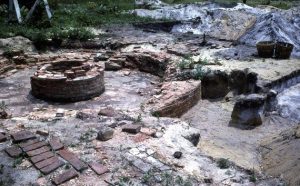 Batsto Village’s diverse history spans from its founding as an eighteenth-century iron furnace, to its revival as a nineteenth-century gentleman’s farm, to
Batsto Village’s diverse history spans from its founding as an eighteenth-century iron furnace, to its revival as a nineteenth-century gentleman’s farm, to 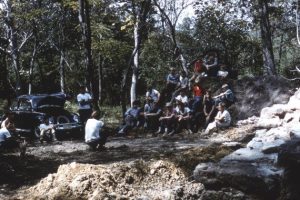
its preservation as an open-air museum in the twentieth century. While it stands today as a beloved
slice of South Jersey culture, Batsto was at serious risk of becoming a ghost town in the mid
nineteenth century—a fate that befell many other Pine Barrens industrial towns. In the 1840s, as
inexpensive, high-quality iron from Pennsylvania threatened to put many New Jersey furnaces out of
blast, Batsto’s owners wisely chose to transition the village’s material output from iron to glass. The
region’s sandy soil was perfect for glass making, and Batsto quickly joined a booming industry. In fact,
according to the National Park Service, almost one-third of the glass produced in the United States
from 1840 to 1860 was manufactured in New Jersey! Jesse Richards, along with his son Thomas H. Richards, established Batsto Glass Works in 1846.
Just a few hundred feet from the site of Batsto’s declining iron furnace, the Glass Works remained open until 1867. Here, panes of glass were primarily produced for
windows and gaslight streetlamps. For example, Batsto Glass Works was part of a massive project in 1852, supplying glass panes for thousands of streetlights used to illuminate the city of Camden. Workers
at Batsto produced glass using the “cylinder method.” Molten glass was gathered at the end of a long blowpipe and swung back and forth in huge swing-pits dug into the ground.
Budd Wilson
|
From the Archives: One of Batsto’s Villagers
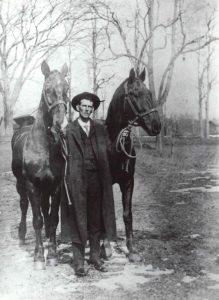 If you have spent time at Batsto, you have probably seen the Miller family name throughout the village! Pictured in the photo above is Augustus “Gus” Miller, who once
If you have spent time at Batsto, you have probably seen the Miller family name throughout the village! Pictured in the photo above is Augustus “Gus” Miller, who once
called Batsto Village his home. The caption on the back of the photo reads: “Batsto Mansion / Taken March 1907 / Augustus Miller son of John Wesley Miller + Ellen
Downs Ford Miller. Born at Batsto May 2, 1872 / Died Dec 1, 1949 at his sister’s in Penbryn. Buried Batsto-Pleasant Mills Cemetery. Never Married. Great uncle to Theda
Ashton” The United States Census provides historians key insights. On the 1910 US Census, recorded just three years after the photograph was taken, Gus was listed as
living with his widowed mother in Batsto Village. He was employed as a “teamster,” in charge of driving the team of horses pictured with him. Gus continued to live in
Batsto (recorded as Washington Township) through the 1940 US Census and, according to his obituary, was a lifelong resident of the village “except for three years at his
sister’s home.” The Miller family’s roots run deep in Batsto history. Gus’s father, John Wesley Miller, appeared on the 1850 US Census as a nine-year-old, living in
Washington Township with his parents and eight siblings. Although the census does not individually specify Batsto as his place of residence, one can suspect that the
Millers were in fact living in the village, as Jesse Richards and his family are listed just three pages later, residing within Batsto Mansion!

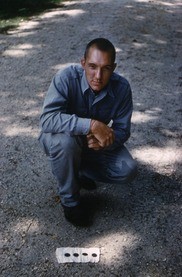 While the history of Batsto Glass Works is a key part of the village’s story, just as important are the twentieth and twenty-first century archaeological and interpretive efforts to uncover, preserve, and share that history. Perhaps no other figure is as important to the archeological work within “the Wharton Tract” as Budd Wilson. Sadly, Budd passed away earlier this year at the age of 90. It is with immense appreciation and profound respect for Budd’s work and legacy that we at Wharton State Forest are able to build on his discoveries and write the next chapters of South Jersey history.
While the history of Batsto Glass Works is a key part of the village’s story, just as important are the twentieth and twenty-first century archaeological and interpretive efforts to uncover, preserve, and share that history. Perhaps no other figure is as important to the archeological work within “the Wharton Tract” as Budd Wilson. Sadly, Budd passed away earlier this year at the age of 90. It is with immense appreciation and profound respect for Budd’s work and legacy that we at Wharton State Forest are able to build on his discoveries and write the next chapters of South Jersey history.